Vol 4 No. 11 TROPIC LIGHTNING NEWS March 17, 1969
Index
February: Cruel Days For Charlie
By PFC Harold Anderson
CU CHI - Fortunately for VC and NVA forces February was a short
month. But unfortunately for Charlie, the 28 days of February marked
substantial losses in men and material.
During last month Tropic Lightning soldiers killed 1,040 enemy and
discovered a mammoth enemy cache containing more than 315 tons of rice. (See
pages 4 and 5 for details on rice story.) Division troops also
captured 306 enemy small arms and 148 crew-served weapons.
With the approach of the Tet holidays in the middle of the month,
intelligence reports indicated that VC and NVA elements planned attacks similar
to those they had sprung during Tet, 1968.
Finally, near the end of the month, the enemy came out of hiding
and launched coordinated attacks on 25th Division base camps at Dau Tieng and Cu
Chi, as well as fire support bases Diamond and Mahone II and other locations.
At Dau Tieng, infantrymen, cooks, clerks and other support elements
of the 3d Brigade killed 73 of the enemy who had penetrated portions of the
camp's perimeter. During the attack, hundreds of rockets, mortars, and
RPG rounds struck the base camp.
With the coming of daylight, the 3d Brigade soldiers had driven the
enemy out of the camp, detaining 13.
Enemy munitions captured at Dau Tieng included forty 60 millimeter
mortar rounds, 76 B-40 rounds and seven launchers, 26 B-41 rounds and one
launcher, 25 AK-47s, 205 satchel charges, 29 RPG boosters, five bangalore
torpedoes and three claymore mines.
At Cu Chi, the enemy launched a three-pronged ground assault
against division headquarters. Elements of an estimated NVA "sapper"
battalion infiltrated the camp's perimeter, but due to quick work by
helicopters, artillery, and spookies, they were repelled. Thirty-one enemy
were killed and eight more were detained.
Confiscated during the fray were 36 RPG rocket launchers, three
AK-47 rifles, 125 satchel charges, 38 grenades, and one bangalore torpedo.
Tropic Lightning soldiers at Fire Support Base Diamond, three miles
southwest of Go Dau Ha turned back a hard-hitting attack by an estimated two
regiments of NVA. During a 10-hour battle, the small U.S. base put out
maximum fire and called in air strikes and artillery to force the enemy into the
killing zone.
By the time the enemy was driven off, the Americans tallied 185
enemy killed in two days of action. Weapons captured included 12 AK-47s,
seven RPG launchers and 53 rounds, two pistols, three 60mm mortars complete and
15 rounds, and four 82mm mortar rounds.
At Fire Support Base Mahone II, southeast of Dau Tieng, 3d Brigade
infantrymen repulsed still another attack by an unknown number of enemy, killing
38 of them.
In Boi Loi Woods
Horsemen Find Battalion's Supplies
CU CHI - Trailing an elusive enemy through the Boi Loi Woods, B and
C troops of the 3d Squadron, 4th Cavalry, uncovered enough supply caches to feed
and clothe a battalion of North Vietnamese Regulars.
In a two-day sweep, the troopers destroyed more than 100 bunkers,
fighting positions and tunnels. The largest of the bunkers measured
50-feet long, six-feet tall and four-feet wide.
The largest complex was dug in at the edge of a thick woodline and
surveyed a broad, grassy plain. The area had been heavily saturated by B52
strikes and the bunkers did not seem to be recently occupied.
In another area, fresh blood was found in a bunker used as a
dispensary. The area was bombed during the previous night. It was
estimated that the enemy had fled a few hours before the Cav arrived.
Some of the clothing was destroyed, but the ARVNs distributed most
of it to civilians.
A one-hundred pound bomb, a 155mm howitzer round, two RPGs, 200
rounds of 7.82 ammunition and 500 feet of rope were also found and destroyed.
Twenty-six bicycles were discovered. The Cav destroyed some of the bikes
while others were transported to Cu Chi base camp for use by the troopers.
In other locations, 7,600 pounds of rice were uncovered. Some
of the 100-pound bags of rice were found lying in brush thickets, others were
buried at the foot of a large tree, used as a landmark by the NVA. Some of
the rice was destroyed by scattering it over the ground; the rest was given to ARVN units working with the Cav on the
sweep operation.
Twelve barrels containing more than 700 sets of men's clothing
were found in one tunnel complex. The clothing consisted mostly of shirts,
trousers and shorts.
Sergeant First Class Donald E. Clark of Laurel, Yd., intelligence
NCO, estimated that the clothing was made by communist sympathizers for NVA
units infiltrating into the Boi Loi Woods from Cambodia.
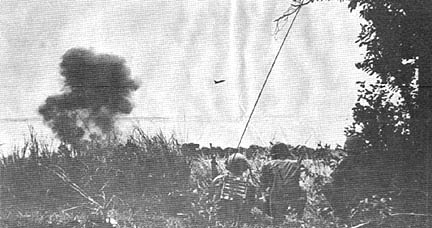 |
| WITH A LITTLE HELP FROM OUR FRIENDS - Three soldiers from the 4th Battalion, 9th Infantry, watch as a tactical air strike slams a suspected enemy position. Major Harry D. Ray, Jr., Dillon, Mont. (center), Manchu operations officer called in the air strike. (PHOTO BY PFC RALPH NOVAK) |
Page 2 TROPIC LIGHTNING NEWS March 17, 1969
Decorated
| Army
Commendation Medal (Heroism) |
|
| MAJ Jerome Johnson,
HHC, 3d Bn, 22d Inf SGT Jack A. Gainey, Co B, 3d Bn, 22d Inf SGT Darwin Duane German, Co B, 3d Bn, 22d Inf SGT Miguel Cruz, Co. A, 1st Bn, 5th Inf SGT Clovis Cook, Co B, 3d Bn, 22d Inf SP5 Daniel F. Farren, Co B, 25th Avn Bn SP5 Edward T. Lyons, Co B, 25th Avn Bn CPL Otis Fortson, C Btry, 7th Bn, 11th Arty CPL Jerome Vice, C Btry, 7th Bn, 11th Arty CPL Albert L. Franklin, B Btry, 7th Bn, 11th Arty CPL Michael Fletcher, B Btry, 7th Bn, 11th Arty CPL Jesus Rivera, B Btry; 7th Bn, 11th Arty CPL Francis K. Whitney, Jr., B Btry, 7th Bn, 11th Arty SP4 George J. Maies, B Btry, 7th Bn, 11th Arty SP4 Joseph K. Verdugo, B Btry, 7th Bn, 11th Arty SP4 William Mitchell, B Btry, 7th Bn, 11th Arty SP4 John R. McKee, B Btry, 7th Bn, 11th Arty SP4 Able A. Garcia, B Btry, 7th Bn, 11th Arty SP4 Victor B. Hernandez, B Btry, 7th Bn, 11th Arty SP4 David Miller, B Btry, 7th Bn, 11th Arty SP4 Carline Guffey, Jr., B Btry, 7th Bn, 11th Arty SP4 Gerald H. Krell, B Btry, 7th Bn, 11th Arty SP4 James B. Squires, B Btry, 7th Bn, 11th Arty SP4 William T. Linebaugh, Co B, 25th Avn Bn SP4 Harry J. Lebherz III, B Btry, 7th Bn, 11th Arty SP4 Richard Rodrigues, Co B, 25th Avn Bn SP4 John Howe, Co B, 3d Bn, 22d Inf SP4 Bruce Williamson, Co B, 3d Bn, 22d Inf SP4 William Washington, Co B, 3d Bn, 22d Inf SP4 Phillip McFarland, Co A, 1st Bn, 5th Inf SP4 Kenneth E. Melton, Trp B, W Sqdn, 4th Cav SP4 Rufus Eggleton, Co B, 3d Bn, 22d Inf PFC David J. Lively, C Btry, 7th Bn, 11th Arty PFC James E. Scannell, Co A, 1st Bn, 5th Inf |
PFC Willie Wittkopf, Co B, 3d Bn, 22d Inf PFC Randy Wicklace, Co B, 22d Inf PFC Angel Escobar, Co A, 1st Bn, 5th Inf PFC Fred Marcus, Co B, 3d Bn, 22d Inf PFC Louis Yussim, Co A, 1st Bn, 5th Inf PFC Thomas P. Lazarz, Co A, 1st Bn, 5th Inf PFC Robert Colquitt, Co B, 3d Bn, 22d 1nf PFC Michael Davidson, Co B, 3d Bn, 22d Inf PFC Billy W. Disheroon, A Trp, 3d Sqdn, 4th Cav PFC Charles Potts, C Btry, 7th Bn, 11th Arty PFC Gerald Bussell, C Btry, 7th Bn, 11th Arty PFC Larry Thompson, B Btry, 7th Bn, 11th Arty PFC William A. Stapleton, C Btry, 7th Bn, 11th Arty PFC Douglas Jenkins, C Btry, 7th Bn, 11th Arty PFC Eugene P. Morse, B Btry, 7th Bn, 11th Arty PFC Arthur Swanson, C Btry, 7th Bn, 11th Arty PFC Willie Stamper, C Btry, 7th Bn, 11th Arty PFC Joseph Johnson, C Btry, 7th Bn, 11th Arty PFC Paul Lamicellia, C Btry, 7th Bn, 11th Arty PFC Anthony Mitravich, C Btry, 7th Bn, 11th Arty PFC Arthur Cole, C Btry, 7th Bn, 11th Arty PFC Leslie Mathews, C Btry, 7th Bn, 11th Arty PFC Dennis Mullins, C Btry, 7th Bn, 11th Arty PFC Richard L. Bell, Jr, 7th Bn, 11th Arty PFC Fred Pelegrini, C Btry, 7th Bn, 11th Arty PFC David Stairs, C Btry, 7th Bn, 11 th Arty PFC Tommy Sims, C Btry, 7th Bn, 11th Arty PFC Rodney M. Boswell, B Btry, 7th Bn, 11th Arty PFC Alvin L. Garner, Jr, B Btry, 7th Bn, 11th Arty PFC Charles Burley, B Btry, 7th Bn, 11th Arty PFC Carl Blackburn, B Btry, 7th Bn, 11th Arty PFC Donald Bennett, C Btry, 7th Bn, 11th Arty PFC David L. Binion, B Btry, 7th Bn, 11th Arty PFC Darold Schaetz, C Btry, 7th Bn, 11th Arty |
Think 'Weapons Safety,' It's A Very Vital Thing
Betcha didn't know that during a recent four month period, nearly
a platoon of men were thoughtlessly killed by friendly weapons in familiar
surroundings by their buddies.
Stupid acts and silly games cause all too many accidents.
Most men find it hard to carry around a 105mm howitzer or "quick draw" an
81mm mortar. So, naturally this isn't what is doing the damage to our
pals. The weapon most frequently toted by the troops seems to be the
natural for causing the most accidents.
Perhaps a reward should be posted — WANTED ALIVE, ALL HANDLERS OF
THE M16. They sure aren't going to be of any value dead or lying in the
hospital. This weapon has been involved in the most accidents - 27 per
cent during the four month period.
Pardner, the M16 was built to kill, and for that reason most men
keep it close to them. The trouble is that some guys tend to become too
careless with it. You wouldn't relax with the "two-step" snake next
to you, you'd be mighty careful. The M16 can strike twice as fast!
"Quick-draw McGraw" that's what some boys favor themselves
as. Men wouldn't be so blasted foolish. Boys discard the issue
holster for the .45 caliber automatic and buy one of those low slung, hip huggin',
fast draw getups with a belt for all the cartridges. Then they swagger
around practicing their quick-draw bit.
Soldier, did you ever try to slap leather with an Army issue .45?
'Bout the only thing you're gonna do is shoot yourself in the leg.
That smarts.
But big, tough, shoot 'em up cowboys can take care of themselves.
They're really doing their part in this war when they're laid up in the
hospital recovering from their self-inflicted wounds. Some people never
grow up.
Although the M16 and the .45 are tops in the accident listings the
M14 and M79 grenade launcher do their part to keep the averages high. Of
course the weapon isn't to blame. It's the loose nut behind the
trigger.
There are other telling statistics. The 19, 20, and
21-year-old privates first class pull between 40 and 50 per cent of the stunts
that put their buddies in the hospital or six feet under. Twenty-five per
cent of those involved in accidents were E4s. Some of these careless
statistic makers reached the ripe old age of 22. And some didn't.
Perhaps it is because men tend to relax in base camps that more
than half of the accidental shootings occur there. This is where most
soldiers clean their weapons, are on guard duty and are off duty.
A little less than 10 per cent of the incidents occur with soldiers
on guard duty. One fatal accident took place when one young man was riding
in the back of a quarter ton. His rifle, an Ml6, was resting on the floor
with the muzzle leaning against the man's thigh. The jeep hit a hole in
the road and the weapon discharged. He died as a result of chest injuries.
Activities like burning trash and tampering with ammunition took
their toll. One man was seriously injured when he took a steel rod and hit
the primer in a 105 round. The round exploded! There have even been
incidents of injuries resulting after some fool dropped live ordnance into
burning trash.
| The Commander's Supply & Maintenance
Handbook is now available from pinpoint distribution centers. The
handbook, DA Pamphlet 700-2 (December, 1968), is particularly helpful to
commanders at company and battalion levels on supply and maintenance operations. Your commander has a copy - Do you? |
VA. Pamphlet Explains SGLI
A Veterans Administration pamphlet explaining insurance protection
and the conversion privilege under the Servicemen's Group Life Insurance (SGLI)
Program will soon be included in a soldier's separation papers.
Information pertaining to SGLI coverage is now contained on DD Form
214 (Armed Forces of the United States Report of Transfer of Discharge) which
will be used to establish conversion eligibility. Thus, it will no longer
be necessary for an ex-serviceman to send VA Form 29-8284 to the SGLI office to
obtain specific authorization to convert to an individual policy.
Additionally, within 30 days following separation, VA will send
each person covered by SGLI additional insurance information together with a
list of all participating companies.
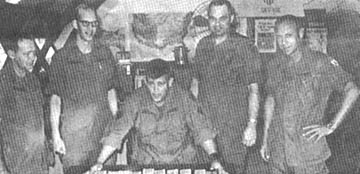 |
A COOL TEN Gs - SP5 Ronnie W. Gholson got it, the largest re-up bonus paid by the 25th in Vietnam, for re-enlisting with A Company, 125th Signal. Watching him protect his loot are (from left) MSGT H. J. Donahue, career counselor; CPT J. R. Peterson, re-enlistment officer; LTC B. P. Matthey, 125th Signal Battalion CO; and SFC S. L. Roach, career counselor. |
Log Officers Needed, EM Can Apply For Direct Commission
To alleviate the serious shortage of infantry lieutenants in
Vietnam, qualified personnel in grades E5 through E9 are urged to apply for
direct appointment as commissioned officers in the infantry.
Applicants must have completed at least six months honorable active
duty as a warrant officer or enlisted man in grades E5 through E9 in any
component of the armed forces.
Completion of the Army pre-commission extension course is not
required but is desirable for personnel without wartime service.
Applicants must not have reached their 28th birthday at date of appointment.
Waiver of maximum age limitations can be considered in certain cases.
Complete details concerning application for direct commission are
contained in AR 135-100 and DA Circular 601-24.
The infantry is concerned not only with acquiring new officers
through the direct commission program, but is equally interested in retaining
company grade officers it now has.
Approximately half of the officers on active duty have less than
two years service. More than two-thirds of these young lieutenants leave
the Army after two years rather than staying on long enough to be promoted to
captain.
Junior officers serving initial two year obligated tours can
greatly enhance their Army Reserve {USAR) promotion status by remaining on
active duty for an extra year. This will permit them to be advanced to AUS
captain and to fulfill the additional active duty commitment that goes with this
promotion. The officer would then be appointed to the permanent grade of
USAR captain upon release from active service.
Officers separated from active duty as first lieutenants are
appointed 1LT, USAR and are not eligible for promotion in the Reserves until
completing: (1) two years in grade if affiliated with a Reserve unit and (2)
four years in grade and six years total commissioned service if not affiliated
with a Reserve unit.
The TROPIC LIGHTNING NEWS is an authorized publication of the 25th Infantry Division. It is published weekly for all division units in the Republic of Vietnam by the Information Office, 25th Infantry Division, APO San Francisco 96225. Army News Features, Army Photo Features, Armed Forces Press Service and Armed Forces News Bureau material are used. Views and opinions expressed are not necessarily those of the Department of the Army. Printed in Tokyo, Japan, by Pacific Stars and Stripes.
MG Ellis W. Williamson . . . . Commanding General
MAJ John C. Fairbank . . . . . Information Officer
2LT Don A. Eriksson . . . . . . Officer-in-Charge
SP4 Stephen Lochen . . . . . . Editor
SP4 Charles Withrow . . . . . . Assistant Editor
SP4 Jim Brayer . . . . . . . . . . . . Production Supervisor
Page 3 TROPIC LIGHTNING NEWS March 17, 1969
Crater Analysis Team Braves In-Coming Rocket-Mortar Fire
By SP4 Pete Freeman
TAY NINH - The prompt and effective reaction to enemy shelling of
fire support bases and base camps depends on a rapid determination of the
location of the enemy weapons and direction from which the rounds were fired.
One of the most positive methods of obtaining information
concerning enemy weapons locations, new types of ammunition, and tactics, is by
the systematic examination of craters and shell fragments.
For this reason, each artillery battery in the 25th Infantry
Division has its own crater analysis team. The members are specially
trained in crater analysis and must know all the many different types of
communist made mortars and rockets.
Headquarters Battery, 7th Battalion, 11th Field Artillery's team
is made up of First Lieutenant Ronald L. Schuckman, Cincinnati, Ohio; Sergeant
First Class Ignacio Sanchez, San Antonio, Tex.; Sergeant First Class Lawrence E.
Howe, Salt Lake City, Utah; and Specialist Four Gregg Lenegar, Greensburg, Kan.
The team covers the whole Tay Ninh base camp, Tay Ninh East and surrounding
hamlets.
The initial step in crater analysis is to locate a usable crater
for determining the direction to the hostile weapon. The crater should
make a a clearly defined pattern on the ground, indicating the trajectory of the
projectile, and should be reasonably fresh. For this reason, it is
necessary for the crater team to move quickly to the location where incoming
rounds are landing.
After determining the direction, they shoot back azimuths and draw
the line of direction on a map. This information is then radioed in to the
fire direction center so that immediate counter-fire can be effectively placed
on the enemy firing position. Besides locating the direction from which
the round was fired, the crater analysis team must also identify the type and
caliber of weapon.
Knowing the type of weapon being used and its maximum range, plus
the line of direction and the angle of the crater, the crater analysis team then
calls in a complete "Shelrep" to the fire direction center (FDC). At
this time FDC knows exactly where the enemy is firing from. Their maps
show confirmed locations which the enemy has surveyed and repeatedly used.
Golden Dragons Touch The Hearts Of Many
By SP4 Robert Ames
CU CHI - Occasionally in the violence of war, an event takes place
which restores our faith in mankind. Such an event occurred recently in
the 25th Infantry Division.
Soldiers of the 2d Brigade of Tropic Lightning had the chance to
bid farewell to a young Vietnamese boy who is taking his first trip to the
United States.
The boy's trip is not a pleasure trip. Upon his arrival in
Miami he will begin a fight for his life. The youth's name is Thi Van
Liep who, since the age of 10, has suffered from a severe heart defect.
Approximately four months ago Thi's condition was discovered by
the men of the 2d Battalion, 14th Infantry, while questioning possible VC
suspects at Fire Support Base Keene. Brought to the attention of Doctor
Richard Tessler of Miami, Fla., the youth's condition was diagnosed as severe
enough for consultation with a heart specialist in Saigon.
The results of the examination showed the boy's condition as
critical. Without special heart surgery Thi would die in less than one
year.
Upon his arrival back at Cu Chi, the men urged him to look into the
possibility of treatment outside Vietnam.
After more than four months of seeing Vietnamese and American
officials, Tessler arranged for the boy to undergo surgery free of charge.
Tessler said of the Golden Dragons, "I have never seen such
enthusiasm in a group of men to try and help someone as I have seen in these
men.
"They just didn't seem to be able to do enough. They
donated $500, which paid for the child's partial ticket that we bad to buy
from San Francisco to Miami," Tessler continued. "They chipped in
enthusiastically and paid much more than we had asked for that part of the
ticket. We had to clothe him and buy him toiletries. All this money
was also donated by the Golden Dragons."
Tessler concluded, "Everyone from our battalion commander down to
the newest PFC in the battalion has done everything he could."
A boy who for the past five years watched American technology
perform the tasks of war will get a chance to see what Americans are most proud
of - the use of skills and technology in the art of saving lives and making
life a little more comfortable.
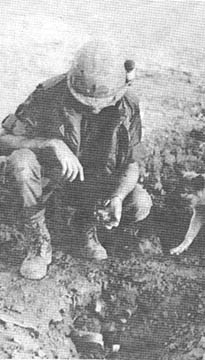 |
CRATER ANAIYSIS - First Lieutenant Ronald Schuckman determines the line of direction of an incoming round during a mortar attack He gets little help from a curious friend. (PHOTO BY SP4 PETE FREEMAN) |
East No Mystery To Manchu
TAY NINH - Most U.S. servicemen in Vietnam are seeing Asia for the
first time, but when Specialist 4 Philip R. Schoonmaker of the 4th Battalion,
9th Infantry Manchus arrived at Bien Hoa he was returning to the continent where
he has spent 15 of the 20 years of his life.
The son of missionary parents, Schoonmaker has always lived in
India except for five scattered year-long stays in the States.
Schoonmaker, a Charlie Company mortarman, spent a homesick year at
a Missouri college before he volunteered for the draft in 1967 "to try to get
better adjusted to American life."
"There's a colony of American missionaries where we live at the
foot of the Himalayan mountains, with an all-American high school and
everything," he says.
"So we don't live much differently than Americans do in the
States, and we keep up with the music, fashions, and things like that. But
when I went to college I was really homesick, so badly that I was physically
sick."
Even though he felt at home in India, living there didn't make it
easier for him to adjust to Vietnam.
"The war being what it is, I haven't had much opportunity to
learn about the Vietnamese or their culture, so I can't even compare them with
Indians except to say that the Vietnamese appear healthier because they have
more food here."
"I wasn't even prepared for the heat and terrain, because our
part of India is relatively cool, and the land isn't anything like the endless
rice paddies you see here."
India did, however, familiarize Schoonmaker with the reputedly
universal Asian trait American soldiers hear so much about - patience.
"They believe that their present life is just one of millions
they've had in the past and will have in the future, so why should they get
upset about anything that happens today when they have all of eternity to make
up for it?"
He's also looking forward to returning to his favorite hobby -
hunting tigers, panthers and Himalayan bears in the hills and rain forest near
his home.
His parents, the Rev. and Mrs. Paul D. Schoonmaker, are living in
Hartford, Conn., while his father finishes work on his Ph.D. in theology at
Hartford Theological Seminary. Schoonmaker says his father, who formerly
did village evangelistic work, now tapes broadcasts for the Far East Radio
Network.
| OOOOOOO! - Specialist 5 Keith Caylor of Kevil, Ky., gives an inoculation to a young villager who imagines all sorts of evil things. (PHOTO BY SGT. JAN ANDERSON) | 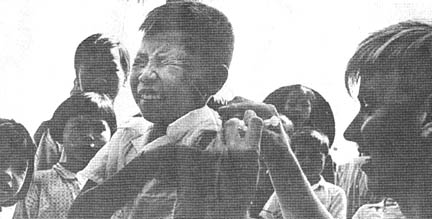 |
Page 4-5 TROPIC LIGHTNING NEWS March 17, 1969
It Was A Real Rice Day
Lancers Find Huge Cache In Tay Ninh Province
TAY NINH - One of the largest rice caches ever found in Tay Ninh
Province was recently uncovered by the 1st Brigade, 11 and one-half miles
northwest of Tay Ninh City. The Tropic Lightning soldiers unearthed more
than 315 tons of contraband rice and a VC sanctuary used for months as a
training camp for NVA troops.
A herd of about 100 oxen walking along a small trail in Vietnam
near the Cambodian border provided the initial clue that led to the discovery of
the camp, setting a massive plan in motion involving every branch of allied
combat forces.
A few days before the operation began, Major John R. Bodie of
Albuquerque, N.M., a 1st Brigade forward air controller, spotted the oxen while
on a visual reconnaissance mission in his OV-10 spotter plane.
"I swept in to take a close look and the oxen dispersed into a
wood line," said Bodie. "I felt someone was up to the old Sioux Indian trick
of slinging arms and ammunition underneath the animal."
"Major Bodie asked me to fly and take a closer look," said 1st
Lieutenant Daniel W. Goins of East Point, Ga., the pilot of a light observation
helicopter from Charlie Troop, 3d Squadron, 17th Cavalry.
"I skimmed in at treetop level and spotted 12 graves with bags of
rice on them, command bunkers, chickens, clothing, hootches with tin roofs, and
several shower stalls," continued Goins. "I was so close that I could
smell cooking odors in the area as I flew over. The stockpiles of rice
were hard to spot because they were camouflaged with green plastic."
Soon Major Bodie was airborne again calling air strikes into the
complex.
"We kept bombing, and the more we bombed the more we
uncovered," said Bodie. "In two days we called in 22 air strikes."
In preparation for his company's sweep of the area, Captain John
Dorsey, Jr., of Yonkers, N.Y., commanding officer of Company D, 3d Battalion,
22d Infantry, flew over the site to familiarize himself with the terrain.
"The pilot dived straight down at the base camp, and we were
surrounded by .51 caliber tracers," said Dorsey. "They formed a cone
of red around us. We couldn't break out of the dive so we continued on
down.
"I guess the VC thought we were going to play kamikaze with them
because they scattered all over the place. Just as I thought we were going
to crash, the pilot pulled out and made a stomach-rattling roll that took us out
of the enemy's range," continued Dorsey.
The following morning Bravo and Delta companies of the 3d
Battalion, 22d Infantry Regulars air-assaulted into a landing zone near the
Cambodian border. Air Force Super Sabres had been plastering the area
since dawn.
Under the protective wing of Company A, 4th Battalion (Mechanized),
23d Infantry, and Charlie Company, 3d Battalion, 22d Infantry, battling Bravo of
the 7th Battalion, 11th Artillery, had moved their 105mm Howitzers from Fire
Support Base Washington to support the Regulars, and 155s from the 1st
Battalion, 27th Artillery, jumped out from Fire Support Base Rawlings to lend a
little extra punch.
As soon as the artillery preparation ended, a smokey ship laid a
protective screen while the 187th Assault Helicopter Company operating out of
Tay Ninh and the Hornets from Cu Chi carried Regulars into the fray.
Bravo Company secured the landing zone.
"I expected just about anything to happen when we hit the
ground," said Bravo Company commander, 1st Lieutenant Hugh E. Stephans of
Charleston, S.C. "From the heavy volume of anti-aircraft fire that had
been reported we figured there would certainly be a welcoming party waiting to
greet us," Stephans said.
Delta Company landed immediately after Bravo and headed straight
for the objective. "As soon as we got to the camp we started to find
bunkers and sleeping hootches," said Specialist 4 Gary W. Kirkpatrick of
Whiffler, Calif. "They were largely constructed of bamboo and tin, but
artillery and air strikes leveled almost all of them. We walked right in
and grabbed 27 cases of mortar rounds along with all that rice right from under
their noses."
The enemy gave little resistance to the operation.
"We received a call to fire a contact mission for the Regulars
when they received several incoming mortar rounds while evacuating the rice,"
said B Battery commander Captain John Ricca of Clark, N.J. "We knew they
might really be up against something so we prepared to give them everything they
needed. The enemy tubes were quieted after we fired 580 rounds."
No casualties resulted from the ineffective enemy mortar fire.
Several training aids were found inside the base camp.
Staging platforms and benches indicated that enemy troops were being trained in
the camp.
"Apparently Charlie thought that he was safe in that location
because there was no defensive perimeter set up," said Dorsey. "The
bunkers were for protection from air strikes and artillery only. They had
no fighting bunkers."
Lieutenant Colonel Robert B. Carmichael of Columbus, Ga.,
commanding officer of the 3d Battalion, 22d Infantry, hovered anxiously in his
command and control helicopter as a CH-47 Chinook helicopter lowered a
three-quarter ton truck into the enemy camp.
"The truck was to be used to transport the huge bags of rice from
their six camouflaged storage areas throughout the camp over to the pickup
zone," said Carmichael. "Things had been going extremely well up to
that point, but I was anticipating an enemy attempt to shoot down the Chinook or
truck. None was made, however."
"The 3d of the 22d and their elements handled their tasks so
efficiently that the operation was completed in record time with minimum enemy
interference," said Colonel Charles W. Hayward of Andover Mass., commanding
officer of the 1st Brigade. "The insertion of the infantry was so rapid
and so well covered by air strikes artillery, and gunships that the enemy could
only stand off at a distance and throw in a few harassment mortar rounds, all of
which were way off target."
During the five-day action 1st Brigade forward air controllers were
credited with killing five enemy. Charlie Troop of the 3d Battalion, 17th
Infantry killed two. Charlie Troop also detonated 45 ammo boxes suspected
of containing 120mm mortar rounds with several secondary explosions resulting.
The Regulars evacuated 105 tons of rice, 62 rounds of 82mm mortar
rounds and six 60mm mortar rounds. The entire operation including
artillery and air strikes accounted for 315 tons of rice destroyed or evacuated.
"The NVA officer who signed the hand receipts for that rice will
certainly have a little explaining to do," quipped Captain Dorsey as he headed
into the 1st Brigade tactical operations center for a quick debriefing.
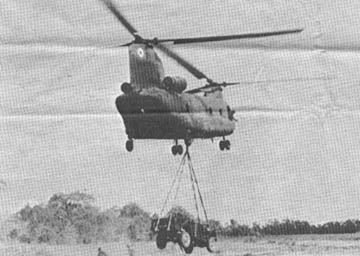 |
A CH-47 CHINOOK helicopter totes a three-quarter ton truck and rice back to Tay Ninh base camp. The move was not without incident. During the evacuation 20 mortar rounds were fired but were off target. Those mortars were the only resistance offered by the enemy, and much of the 315 tons of rice was evacuated. |
| RICE TRUCK - A three-quarter ton truck that was dropped (gently) by a CH-47 Chinook helicopter was loaded with rice from stalls in the NVA base camp. After being loaded, the truck moved to a pickup zone and was carried away the same way it arrived. Approximately 105 tons of rice were lifted out by the Regulars. | 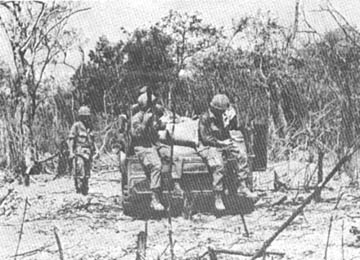 |
|
Story And Photos |
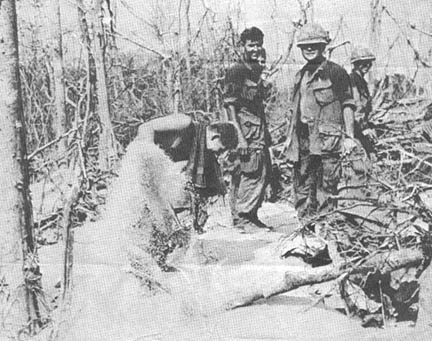 |
| SNOW IN VIETNAM? - It seems that way as Specialist 4 Gary Schattman of Ogden, Utah, shovels rice. Looking on are Specialist 4 John Zukovich of Tomaqua, Pa., and 1st Lieutenant Leslie R. Fransworth of Bohemia, N.Y. |
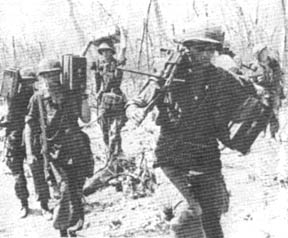 |
CARRYING a load of 82mm mortar rounds from the NVA base camp are members of D Company, 3d Battalion, 22d Infantry. Front to rear are PFC David J. Horsch of Hastings, Mich., SP4 Russ Andrews of St. Louis, SGT Howard N. Nance of Petersburg, Ill., and SP4 Mike Finneran of Detroit. |
| MORE THAN RICE - Specialist 4 Dennis Rhoades of Vernon, Ill., lifted 27 boxes of 82mm mortar ammo out of one bunker. | 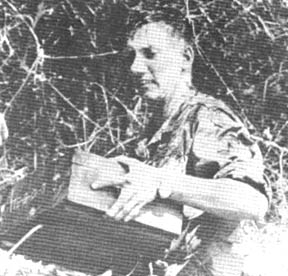 |
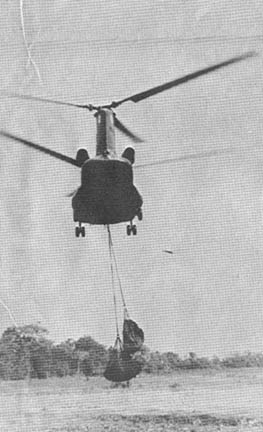 |
AN OUTGOING Chinook lifts part of the 315 tons of rice found by 1st Brigade troops. |
| SLASHING OPEN bags of rice are Specialist 4 Billy Perry of Marquette, Mich. (left), and Sergeant John E. Larson of Twin Falls, Idah. The bags were cut to let enough rice out so the rice could be carried away. | 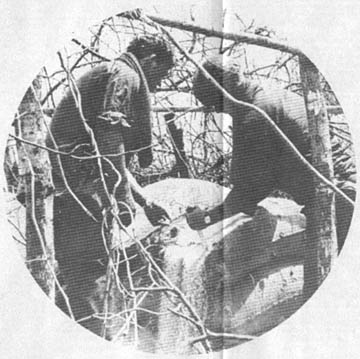 |
Page 6 TROPIC LIGHTNING NEWS March 17, 1969
Combined Recon Patrol Uses A New Approach For APCs
DAU TIENG - A new approach to the use of armored personnel carriers
is paying off for infantrymen of the 2d Battalion (Mechanized), 22d Infantry.
For more than two months the Triple Deuce has been using a patrol
of the armored transports in a new role: reconnaissance. The small,
special purpose force has proved its worth by incorporating special abilities in
serving as a listening post for enemy activities. At the same time it has given
no quarter in its fighting ability.
"With a small unit like this we are able to get close to the
people," said First Lieutenant Michael Andrews of Jacksonville, N.C.,
commander of the combined Reconnaissance Patrol (CRP).
"We are lucky to have ARVN (Army of the Republic of Vietnam)
soldiers as part of CRP since they can talk with the people and have a detailed
knowledge of the terrain," he explained. The ARVNs, all of them
volunteers, supplement 3d Brigade Tropic Lightning soldiers in the unit.
During the day and frequently at night, CRP is active in its goal
of rooting out members of the Viet Cong infrastructure (VCI). Their
armored personnel carriers give the patrol swift mobility and massive firepower.
On one recent night the mechanized infantrymen set out shortly
before midnight to surround a hamlet in the Ben Cui Rubber Plantation, seizing a
trio of women known to supply enemy uniforms and food.
The unit lives separate from the remainder of the battalion
operating out of Bao Don district headquarters, 40 miles northwest of Saigon.
In its special role, CRP does not usually take part in the Triple
Deuce road sweeps and reconnaissance in force operations that comprise the bulk
of an infantry battalion's mission. But when a firefight breaks out CRP
may be among the first units called in to reinforce a Triple Deuce line company.
During the first few weeks as members of the new team, CRP
infantrymen accounted for the capture of 65 known Viet Cong agents and killed
another 25 enemy in small engagements. The unit also captured more than
3,000 pounds of enemy rice, 30 weapons, 300 pounds of high explosives and
hundreds of rounds of ammunition.
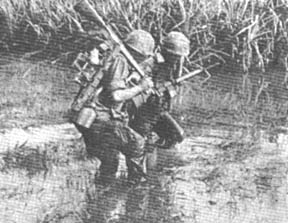 |
HELP OUT - An RTO comes in handy once in a while as Sergeant First Class William J. Woidyla, State College, Pa, will agree. Specialist 4 Donald Winn, Wicheta, Kans, helps him from a soft spot in a swampy area. Both soldiers are from the 2d Brigade's 2d Battalion, 27th Infantry Wolfhounds. (PHOTO BY SP4 KARL KARLGAARD) |
Aimed At Base Camp
Regulars Find Enemy Rockets
TAY NINH - Three enemy 107 rockets were ready to fire and aimed
directly at 1st Brigade base camp at Tay Ninh.
Fortunately the rockets were captured by Charlie Company of the 3d
Battalion, 22d Infantry on an airmobile operation 11 miles west of Tay Ninh
City. Three NVA soldiers were readying the rockets for launch when the
Regulars closed in and began firing. The NVA fled, leaving three 107
rockets, two CHICOM hand grenades, one 60mm mortar, and an aiming quadrant used
to zero in rockets.
Tay Ninh base camp had recently been hit with several rockets
launched from the rocket belt west of the base camp. Alpha and Charlie
Companies of the Regulars were heli-lifted into the area to apprehend the enemy
and confiscate the missiles.
Jumping off choppers into separate landing zones, the companies
closed towards the suspected launching positions. Three NVA were lowering
their weapons to fire when Sergeant William Bangley of Suffix, Va., and Private
First Class Ignacio C. Castro of Monterey, Calif., spotted them.
The Regulars have kept the area under strict surveillance keeping
the rocket belt clear of VCN-VA forces.
By keeping the enemy on the move, the Regulars have taken away his
ability to organize and launch significant attacks.
Combined Task Force Uncovers VC Caches
CU CHI - One of the largest combined operations in the 25th
Infantry Division area of operations in recent months was conducted by
Vietnamese and elements of Tropic Lightning's 2d Brigade at Phu Hoa Dong under
the direction of Task Force Commander Lieutenant Colonel Jack P. Grisham, Anna,
Ill., Brigade Executive Officer.
The task force cordoned the village complex of Phu Hoa Dong during
the first 48 hours. Over the remaining 11 days of the operation, more than
9,000 villagers were questioned for information concerning widespread VC
activity in the district.
Search-and-clear missions turned up numerous caches, enemy
documents and equipment.
U.S. forces taking part in the action were 2d Battalion, 12th
Infantry, 2d Battalion, 27th Infantry, 1st Battalion (Mechanized), 5th Infantry,
2d Battalion, 34th Armor, and the 2d Battalion, 3rd Infantry attached to the 2d
Brigade from the 199th Light Infantry Brigade, plus artillery and air support.
The U.S. accounted for 31 VC/NVA killed.
The Fire Brigade Task Force captured 800 rounds of AK ammunition, a
small quantity of medical supplies, 500 pounds of rice plus dozens of rifles,
mortars machineguns, grenades, personal gear and ammunition.
ARVNs from the 7th Regiment, along with National Police, RF/PF
elements killed 12 VC, apprehended 45 confirmed VC, and questioned 8,831
villagers.
Also, 658 tunnels were destroyed, and one outpost constructed.
The operation was a concentrated effort to eliminate enemy control in what has
been a VC hot spot.
Fire Brigade Has New Commander
CU CHI - In ceremonies at Warrior Hall in Cu Chi, Colonel
H.S.
Long, Jr., Gallatin, Mo. took command of Tropic Lightning's 2d Brigade.
Colonel Long succeeds Colonel Eugene M. Lynch, Green Bay, Wisc.,
who returns to the states short of a normal year's tour because of ear
injuries suffered in a booby trap incident.
Major General Ellis W. Williamson, 25th Infantry Division
Commanding General passed the Fire Brigade colors to Colonel Long from the
outgoing commander.
Directing his remarks to Colonel Lynch, General Williamson said,
"I must once again express my appreciation and admiration in the manner which
he combined the attributes of thoughtfulness, thinking his way through an
action, insuring that his subordinates understand what is wanted and actively
supervising the operation itself."
Colonel Long, a West Point graduate, has been awarded the Joint
Service Commendation Medal, the Bronze Star with Oak Leaf cluster, the Army
Commendation Medal with oak leaf cluster and the second award of the Combat
Infantryman Badge.
Manchus Recover U.S. Ammunition
TAY NINH - If the Viet Cong are going around calling GIs 'Indian
givers' these days, you can blame the 4th Battalion, 9th Infantry Manchus.
A patrol of the Manchus' Charlie Company recently retrieved a
load of U.S. ammunition from an enemy cache while on a sweep near the 1st
Brigade battalion's Fire Support Base Sedgwick, 16 miles southeast of Tay Ninh.
The Tropic Lightning soldiers reclaimed 12,000 rounds of M-16
ammunition in 78 bandoliers, 6,800 rounds of M-60 ammunition and four M-79
grenades. The cache also included a North Vietnamese field radio.
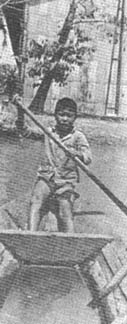 |
FERRY CROSS THE MERSEY - Not this time, but this sampan captain helps make river crossing at III Corps Sugar Mill interesting and easy. The youngsters who have become close friends of the GIs provide their services for fun and profit. (PHOTO BY 1LT J. N. BLACK) |
Page 7 TROPIC LIGHTNING NEWS March 17, 1969
Uptight 7/11 Arty Is Ready To Blast Charlie Anytime
TAY NINH - "Hermit India this is Scull Zero 2, Fire Mission! .
. .Over. Grid279619. . .Nature of target - estimated NVA company in open.
. .Method of fire - Battery One Round, HE. . . . Over."
The grid coordinates are quickly charted at the Battery Fire
Direction Center. Seconds later, six 105mm howitzer rounds are fired.
This is an example of a forward observer calling for artillery
support from B Battery, 7th Battalion, 11th Artillery, at a fire support base
northeast of Tay Ninh City. Throughout this particular fire mission,
Battling Bravo displayed speed and accuracy to accomplish their objective.
Proficiency in their job is by no means accidental, but comes
through much preparation. An unpublicized but vital function of the
artillery is the necessary procedural steps needed to prepare for the fire
mission.
Maintenance on the howitzers is performed daily to insure each gun
is in top working condition. Ammunition is also re-supplied daily to
insure a sufficient amount at all times. The artillery can never be caught
short of ammunition. Each gun section in the battery keeps an adequate
supply of ready rounds, mostly HE (high explosive).
After ammunition is delivered, the rounds are uncrated and fused.
The fuses are screwed on to the projectile with a fuse wrench. The two
main types of fuses are VT (variable time) and PD (point detonating).
Whenever a fire mission is called, the guns must be adjusted to
their proper positions with the correct firing data settings. In the
artillery this is termed laying the guns. The gunner then adjusts a sight
picture on the aiming posts, and the gun is ready to fire.
Day or night, B Battery must be prepared for a fire mission,
anytime a voice may scream: "Fire Mission! ... Battery Adjust! "Firing
data is quickly set on all six guns. Cannoneers break out ammunition and
set given times on the fuses. Next, comes the command: "Battery one
round ... fire for effect!" A round is chambered into each gun.
Then, "Battery ... Fire!" Six 105mm howitzer rounds go airborne.
Bravo Battery is the direct support element for a Tropic Lightning
infantry battalion. Their fire support enables the infantry to accomplish
their objective, whether to provide blocking fire for a recon-by-fire mission,
or to a landing zone.
The fire out by the artillery neutralizes or subdues the enemy and
gives the infantry the advantage. The artillery's role: to provide
continuous, close fire to support the infantry.
Any maneuver element, operating in Vietnam, must have direct
support from an artillery unit to insure a successful mission.
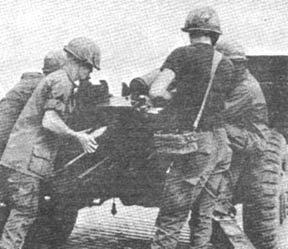 |
SERGEANT Leonard W. Sears, from Woodward, Okla., chambers another 105mm round during a recent fire mission performed by Uptight cannoneers northeast of Tay Ninh City. |
| MAINTENANCE - A gun section from B Battery, 7th Battalion, 11th Artillery, pulls daily maintenance on their 105mm howitzer. From left ot right are Private First Class Michael Garcia, Hawthorne, Nev., Private First Class Dwayne turner, Ava, Mo., and Corporal John Banks, Effingham, Kans. | 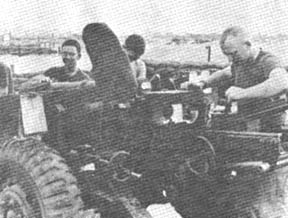 |
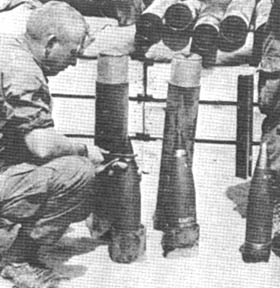 |
FIRE MISSION COMING - Tropic Lightning artilleryman, Corporal John Banks from Effington, Kans., of the 7th Battalion, 11th Artillery, screws a time fuse onto a 105mm howitzer round. |
|
Story and Photos |
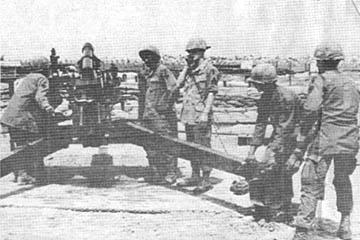 |
| SLIGHT ALIGNMENT - A gun section from B Battery, 7th Battalion, 11th Artillery, 'lay' their howitzer by shifting the trails as the gunner takes up a correct sight alignment while the section chief, on the phone, receives firing data from the executive officer. |
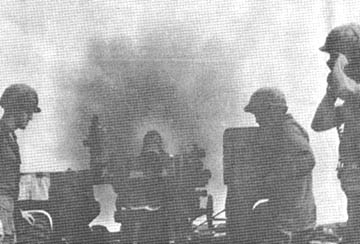 |
| "BATTERY . . . FIRE!" - The assistant gunner pulls the lanyard and another artillery round is sent airborne by B Battery, firing in direct support of the Infantry from a fire support base near Tay Ninh. |
Page 8 TROPIC LIGHTNING NEWS March 17, 1969
Bobcats Kill 25 NVA With Aid From Air
CU CHI - Infantrymen of the 1st Battalion (Mechanized), 5th
Infantry, made a wholesale disruption of one NVA unit's plans.
Near midday of a long sweep near the southeast corner of the Hobo
Woods, men of Bravo Company's third platoon spotted three men wearing NVA
uniforms. Air strikes and gunships covered the area with fire power as
Bobcat companies Alpha and Bravo joined, readying themselves for contact.
The advancing Fire Brigade soldiers began to maneuver into a
superior tactical position. In the process a nearby hedgerow suddenly came
alive with enemy soldiers firing RPGs and AK-47s.
One armored personnel carrier driver, Specialist 4 Percy J.
Jennings, Starksborough, Vt., from Bravo Company's third platoon was
practically on top of the action.
Jennings said, "I was 30 meters from the hedgerow when I saw a
flash coming toward me."
Jennings jumped clear of an RPG aimed directly at him, receiving
only minor shrapnel wounds in the leg.
As darkness moved in, enemy fire had been silenced. The two
companies set up a night laager with the aid of concertina wire and extra ammo
dropped by a Chinook.
Early the next morning aided by Charlie Company of the Tropic
Lightning, soldiers swept through the area tabulating the score of the previous
day's battle as they advanced. Twenty-two NVA bodies were found, and
other blood trails indicated that the Bobcats had seriously damaged the NVA
unit. Aside from the body count, the three companies discovered several
caches.
Staff Sergeant Richard L. Hautekeete, Grinnel, Iowa, Bravo Company
second platoon sergeant, in leading his platoon through the burned-out area
noticed an unnatural depression near a tree. Further examination proved
Hautekeete's suspicion. A wooden trap door hastily camouflaged pointed
the way to a large tunnel full of small arms ammunition - 23,400 rounds.
Sergeant Lonnie Cruise, Fair Oaks, Calif. discovered a camouflaged
hole filled with 82mm mortar rounds, 60mm mortar rounds, recoilless rifle rounds
and small arms ammunition.
In yet another tunnel, Private First Class Roger D. Champion
Birmingham, Ala., pulled an outgoing bag of NVA mail. Not to be left out
of the spoils were the men of Charlie Company who detained one suspect.
At the end of the day, the 2nd Brigade soldiers had captured 84
82mm rounds, 48 fuzes, two mortar sights, one 82mm mortar tube, four 60mm mortar
rounds, nine 57mm recoilless rifle rounds, three 75mm recoilless rifle rounds,
three RPG-2 rounds, one RPG-7 round, one RPG launcher, three AK-47s and several
documents.
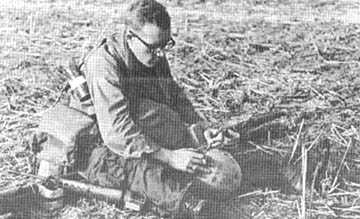 |
HELMET CALENDAR - Specialist 4 Clyde
Pless, Winston Salem,
N C, crosses off another month on his helmet calendar. Pless is a medic
with the 2nd Battalion 27th Infantry Wolfhounds. (PHOTO BY SP4 KARL
KARLGAARD) |
A Tet Party For 3/4 Cav
CU CHI - Last Christmas Eve, the troopers of the 3rd Squadron, 4th
Cavalry, gave a party for the children of Bac Ha's orphanage.
Recently, the orphanage responded with an invitation to the
troopers to come to a party of their own. This one was in celebration of
Tet.
The children, ages 7 to 12 years old, had written poems for the
occasion of the soldiers' visit and sang songs and danced for them. The
GIs in turn sang American folk songs for the children. When they sang
"Auld Lang Syne," the children responded with the same tune sung in
Vietnamese lyrics.
Father Phan, the head of the orphanage, explained the significance
of Tet to the men from Tropic Lightning.
"For us, Tet is Christmas, New Years, Easter, the 4th of July and
our birthdays all rolled into one holiday. Everyone becomes a year older
during Tet. This is the beginning of the Lunar Year. We are ushering
in the Year of the Cock; last year was the Year of the Monkey. During the
Tet season, all the children are on vacation, and we give parties such as this
one we invited you to."
Regulars Join In Act - Find VC Hideout
TAY NINH - While on an airmobile operation six and one-half miles
northwest of Tay Ninh, Charlie Company of the 3d Battalion, 22d Infantry
Regulars uncovered a VC mess hall equipped to accommodate a company-sized enemy
force. Destroyed was one large hut six cooking pits, three bunkers, 100
pounds of rice, a sampan dock and assorted eating utensils.
The complex was found on the banks of the Rach Ben Da River, deep
in the VC-infested jungles of War Zone C. It was estimated to have been
built seven days before and used up to a few hours before the Regulars moved in.
"It was a great setup for a barbecue," said Captain Donald
Haramoto of Makawao, Maui, Hawaii. "The pots and pans were still on the
fire and the tables were set up with the utensils in place. From the looks
of the setup, it appeared that the mess hall had its own staff to prepare the
meals and feed the VC who would dock their sampans and leave after they finished
eating."
The mess hall was constructed out of bamboo and palm.
Surrounding it were several tables and chairs and three large bunkers with eight
feet of overhead cover. The six cooking stoves were constructed like huge
barbecue pits with the coals still glowing red when the Regulars arrived.
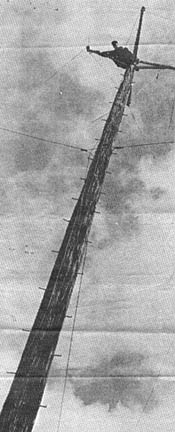 |
HELLO DOWN THERE - Specialist 4 Cranston Haiku, wire team chief with DIVARTY's Headquarters Company, gets a different outlook on the world 90 feet skyward. Haiku hails from Honolulu and was stationed with the 3d Battalion, 13th Artillery when it was at Schofield Barracks. (PHOTO BY SGT KARL GUTKNECHT) |
Thanks to
Mack D. Gooding, 15th PID, 1st Bde., for sharing this issue,
Kirk Ramsey, 2nd Bn., 14th Inf. for creating this page.
This page last modified 8-12-2004
©2004 25th Infantry Division Association. All rights reserved.